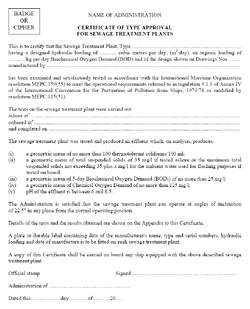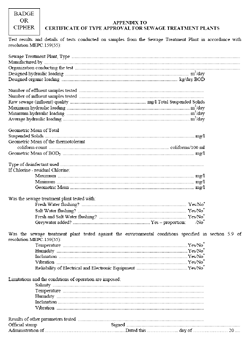|
5.3 Duration and timing of test
5.3.1 The duration of the test period should be a minimum of 10 days and should be timed to capture normal operational conditions, taking into account the type of system and the number of persons and hydraulic loading for which the sewage treatment plant will be type approved. The test should commence after steady-state conditions have been reached by the sewage treatment plant under test.
5.4 Loading factors
5.4.1 During the test period the sewage treatment plant should be tested under conditions of minimum, average and maximum volumetric loadings.
.1 For testing ashore, these loadings will be as laid down in the manufacturer's specifications. Figure 1 shows suggested timings for sampling each loading factor.
.2 For testing onboard, minimum loading will represent that generated by the number of persons on the ship when it is alongside in port, and average and maximum loadings will represent those generated by the number of persons on the ship at sea and will take account of meal times and watch rotations.
5.4.2 The Administration should undertake to assess the capability of the sewage treatment plant to produce an effluent in accordance with the standards prescribed by section 4 following minimum, average and maximum volumetric loadings. The range of conditions under which the effluent standards were met should be recorded on the Certificate of Type Approval. The form of the Certificate of Type Approval and appendix is set out in the annex to these Guidelines.
5.5 Sampling methods and frequency
5.5.1 Administrations should ensure that the sewage treatment plant is installed in a manner which facilitates the collection of samples. Sampling should be carried out in a manner and at a frequency which is representative of the effluent quality. Figure 1 provides a suggested frequency for sampling, however, the frequency should take account of the residence time of the influent in the sewage treatment plant. A minimum of 40 effluent samples should be collected to allow a statistical analysis of the testing data (e.g. geometric mean, maximum, minimum, variance).
5.5.2 An influent sample should be taken and analyzed for every effluent sample taken and the results recorded to ensure compliance with section 4. If possible, additional influent and effluent samples should be taken to allow for a margin of error. Samples should be appropriately preserved prior to analysis particularly if there is to be a significant delay between collection and analysis or during times of high ambient temperature.
5.5.3 Any disinfectant residual in samples should be neutralized when the sample is collected to prevent unrealistic bacteria kill or chemical oxidation of organic matter by the disinfectant brought about by artificially extended contact times. Chlorine (if used) concentration and pH should be measured prior to neutralization.
|
Figure 1:
|
Suggested hydraulic loading factors and sampling frequency for testing sewage treatment plants. May be modified as necessary to take account of characteristics of individual sewage treatment plants
|
5.6 Analytical testing of effluent
5.6.1 The Administration should give consideration to the recording of other parameters in addition to those required (thermotolerant coliforms, total suspended solids, BOD5, COD, pH and residual chlorine) with a view to future technological development. Parameters which might be considered include total solids, volatile solids, settlable solids, volatile suspended solids, turbidity, total phosphorus, total organic carbon, total coliforms and faecal streptococci.
5.7 Disinfectant residual
5.7.1 The potential adverse environmental effects of many disinfectant residuals and by-products, such as those associated with the use of chlorine or its compounds, are well recognized. It is, therefore, recommended that Administrations encourage the use of ozone, ultra-violet irradiation or any other disinfectants which minimize adverse environmental effects, whilst pursuing the thermotolerant coliform standard. When chlorine is used as a disinfectant, the Administration should be satisfied that the best technical practice is used to keep the disinfectant residual in the effluent below 0.5 mg/l.
5.8 Scaling considerations
5.8.1 Only full-scale marine sewage treatment plants should be accepted for testing purposes. The Administration may certify a range of the manufacturer's equipment sizes employing the same principles and technology, but due consideration must be given to limitations on performance which might arise from scaling up or scaling down. In the case of very large, very small or unique sewage treatment plants, certification may be based on results of prototype tests. Where possible, confirmatory tests should be performed on the final installation of such sewage treatment plants.
5.9 Environmental testing of the sewage treatment plant
5.9.1 The Administration should be satisfied that the sewage treatment plant can operate under conditions of tilt consistent with internationally acceptable shipboard practice.
5.9.2 Tests for certification should be carried out over the range of temperature and salinity specified by the manufacturer, and the Administration should be satisfied that such specifications are adequate for the conditions under which the equipment must operate.
5.9.3 Control and sensor components should be subjected to environmental testing to verify their suitability for marine use. The Test Specifications section in part 3 of the annex to resolution MEPC.107(49) provides guidance in this respect.
5.9.4 Any limitation on the conditions of operation should be recorded on the Certificate.
5.9.5 The Administration should also consider requiring the manufacturer to include in the operating and maintenance manuals, a list of chemicals and materials suitable for use in the operation of the sewage treatment plant.
5.10 Other considerations
5.10.1 The type and model of the sewage treatment plant and the name of the manufacturer should be noted by means of a durable label firmly affixed directly to the sewage treatment plant. This label should include the date of manufacture and any operational or installation limits considered necessary by the manufacturer or the Administration.
5.10.2 Administrations should examine the manufacturer's installation, operating and maintenance manuals for adequacy and completeness. The ship should have on board at all times a manual detailing the operational and maintenance procedures for the sewage treatment plant.
5.10.3 Qualifications of testing facilities should be carefully examined by the Administration as a prerequisite to their participation in the testing programme. Every attempt should be made to assure uniformity among the various facilities.
6 RENEWAL AND ADDITIONAL SURVEYS
6.1 Administrations should endeavour to ensure, when conducting renewal or additional surveys in accordance with regulations 4.1.2 and 4.1.3 of Annex IV, that the sewage treatment plant continues to perform in accordance with the conditions outlined in regulation 4.1.1 of Annex IV.
7 FAMILIARIZATION OF SHIP PERSONNEL IN THE USE OF THE SEWAGE TREATMENT PLANT
7.1 Recognizing that the appropriate regulations relating to familiarization are contained within the Ships Safety Management Systems under the International Safety Management Code, Administrations are reminded that ship staff training should include familiarization in the operation and maintenance of the sewage treatment plant.
ANNEX
FORM OF CERTIFICATE OF TYPE APPROVAL
FOR SEWAGE TREATMENT PLANTS AND APPENDIX
| (拡大画面:98KB) |
 |
|
|
|
| (拡大画面:92KB) |
 |
|
|
|
|